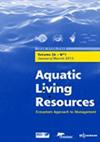Efficiency of automatic analyses of fish passages detected by an acoustic camera using Sonar5-Pro
IF 1.5
4区 农林科学
Q3 FISHERIES
引用次数: 5
Abstract
The acoustic camera is a non-intrusive method increasingly used to monitor fish populations. Acoustic camera data are video-like, providing information on fish behaviour and morphology helpful to discriminate fish species. However, acoustic cameras used in long-term monitoring studies generate a large amount of data, making one of the technical limitations the time spent analysing data, especially for multi-species fish communities. The specific analysis software provided for DIDSON acoustic cameras is problematic to use for large datasets. Sonar5-Pro, a popular software in freshwater studies offers several advantages due to its automatic tracking tool that follows targets moving into the detection beam and distinguishes fish from other targets. This study aims to assess the effectiveness of Sonar5-Pro for detecting and describing fish passages in a high fish diversity river in low flow conditions. The tool's accuracy was assessed by comparing Sonar5-Pro outputs with a complete manual analysis using morphological and behavioural descriptors. Ninety-eight percent of the fish moving into the detection beam were successfully detected by the software. The fish swimming direction estimation was 90% efficient. Sonar5-Pro and its automatic tracking tool have great potential as a database pre-filtering process and decrease the overall time spent on data analysis but some limits were also identified. Multi-counting issues almost doubled the true fish abundance, requiring manual operator validation. Furthermore, fish length of each tracked fish needed to be manually measured with another software (SMC). In conclusion, a combination of Sonar5-Pro and SMC software can provide reliable results with a significant reduction of manpower needed for the analysis of a long-term monitoring DIDSON dataset.使用Sonar5-Pro的声相机自动分析鱼类通道的效率
声学摄像机是一种非侵入式的方法,越来越多地用于监测鱼类种群。声学相机的数据是视频,提供了鱼类行为和形态的信息,有助于区分鱼类。然而,用于长期监测研究的声学摄像机产生了大量数据,这使得分析数据所花费的时间成为技术限制之一,特别是对于多物种鱼类群落。为DIDSON声学相机提供的特定分析软件在用于大型数据集时存在问题。Sonar5-Pro是一款在淡水研究中很受欢迎的软件,由于其自动跟踪工具可以跟踪进入探测光束的目标,并将鱼类与其他目标区分开来,因此具有几个优势。本研究旨在评估Sonar5-Pro在低流量条件下对鱼类多样性高的河流中鱼类通道进行检测和描述的有效性。通过比较Sonar5-Pro输出与使用形态和行为描述符的完整手动分析来评估该工具的准确性。98%进入检测光束的鱼被软件成功检测到。鱼游方向估计效率为90%。Sonar5-Pro及其自动跟踪工具作为数据库预过滤过程具有很大的潜力,并减少了用于数据分析的总体时间,但也发现了一些限制。多次计数问题几乎使鱼类的真实丰度增加了一倍,需要人工操作人员进行验证。此外,每条跟踪鱼的鱼长需要用另一种软件(SMC)手动测量。总之,Sonar5-Pro和SMC软件的结合可以提供可靠的结果,大大减少了分析长期监测DIDSON数据集所需的人力。
本文章由计算机程序翻译,如有差异,请以英文原文为准。
求助全文
约1分钟内获得全文
求助全文
来源期刊

Aquatic Living Resources
农林科学-海洋与淡水生物学
CiteScore
2.30
自引率
0.00%
发文量
10
审稿时长
>24 weeks
期刊介绍:
Aquatic Living Resources publishes original research papers, review articles and propective notes dealing with all exploited (i.e. fished or farmed) living resources in marine, brackish and freshwater environments.
Priority is given to ecosystem-based approaches to the study of fishery and aquaculture social-ecological systems, including biological, ecological, economic and social dimensions.
Research on the development of interdisciplinary methods and tools which can usefully support the design, implementation and evaluation of alternative management strategies for fisheries and/or aquaculture systems at different scales is particularly welcome by the journal. This includes the exploration of scenarios and strategies for the conservation of aquatic biodiversity and research relating to the development of integrated assessment approaches aimed at ensuring sustainable and high quality uses of aquatic living resources.
 求助内容:
求助内容: 应助结果提醒方式:
应助结果提醒方式:


